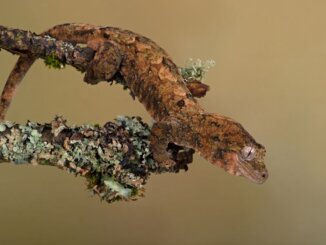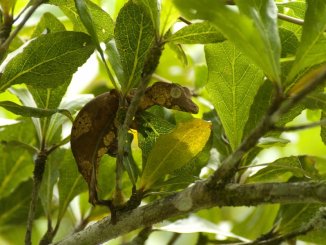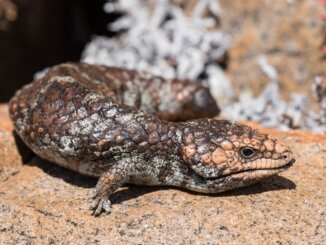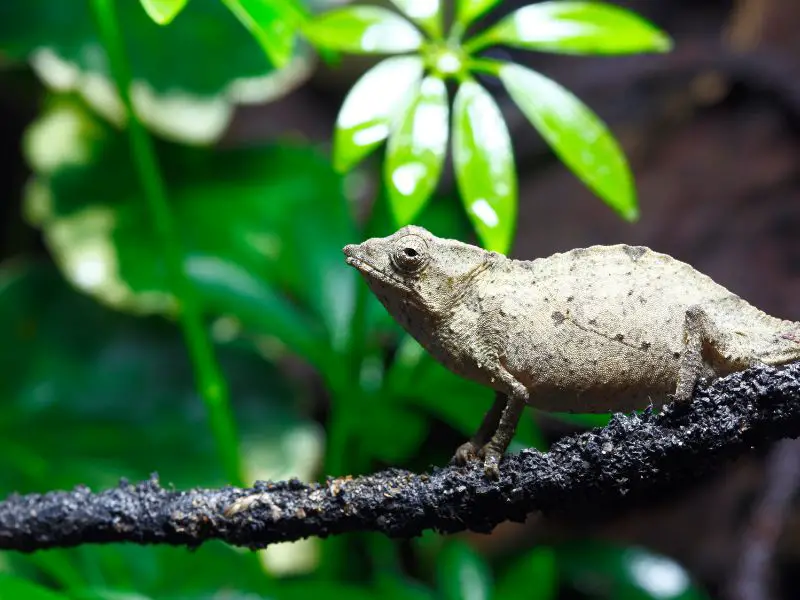
The pygmy chameleon is a tiny lizard reaching only 4 inches in length. These small chameleons are found in forests and woodlands of central East Africa, including countries like Zimbabwe and Mozambique.
Pygmy chameleons are docile and intelligent creatures that can get used to humans. But these are not suitable pets for novice owners due to their fragility, linked to their small size.
While pygmy chameleons aren’t particularly demanding when it comes to care, the lack of the right conditions matching those of their natural habitat can cause these small creatures a lot of harm.
Still, pygmy chameleons make excellent pets for intermediate and above owners who need a pet that requires minimal space at home.
Pygmy Сhameleon Overview
| Common name | Pygmy chameleon, African leaf chameleon |
| Scientific name | Rhampholeon |
| Natural habitat | Forests, woodlands, savannah |
| Adult size | 4 inches |
| Average lifespan | 1–3 years |
| Diet | Insectivorous |
| Housing | 5-gallon tank |
| Experience | Intermediate/Advanced |
Origin
The pygmy chameleon (Rhampholeon) is native to the central regions of East Africa.
Species belonging to the pygmy chameleon genus are found in countries including Tanzania, Mozambique, Zimbabwe, DR Congo, and others.
Pygmy chameleons are a genus of small chameleons that includes as many as 19 different species. Pygmy chameleons are distributed across the African continent and vary in size and coloration.
Pygmy chameleons are ground-dwelling species, living in the grass or leaf litter. Sometimes, these reptiles inhabit low-level bushes.
Pygmy chameleons are quite rare in the wild and are not bred in captivity, which means they may be difficult to find in the pet trade.
Appearance and Behavior
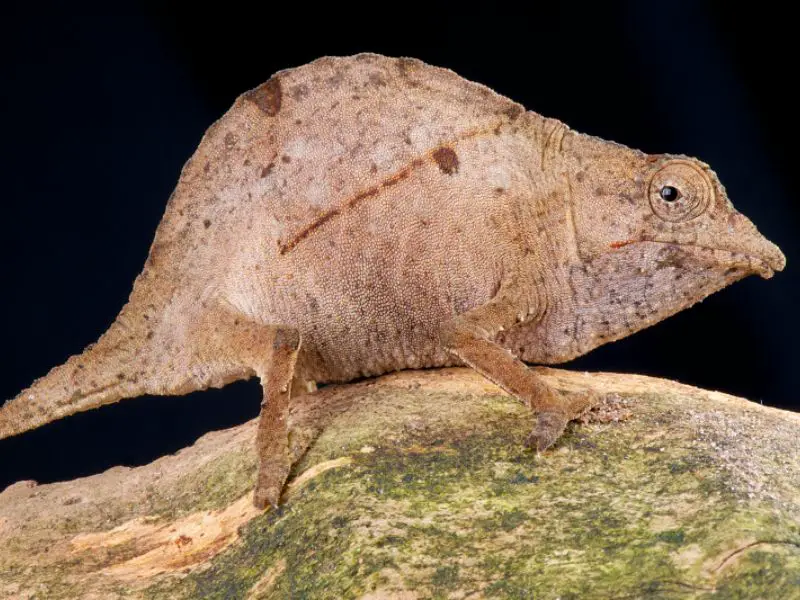
The most popular species of pygmy chameleon in the pet trade include bearded, spectral, and pitted pygmy chameleons.
The typical colors of pygmy chameleons are green, brown, and gray, helping them survive in their natural habitat.
Bearded pygmy chameleons display colors similar to wilted grass and leaves, such as brown and yellow.
This species is recognized by a so-called “beard” of scales in both male and female lizards, surrounding the reptiles’ chins.
Spectral pygmy chameleons are capable of color change, usually shifting between light brown and gray shades to match the background of their natural habitat.
They also have a distinct darker line stretching from the base of their heads to the tails.
Pitted pygmy chameleons are slightly larger and have a body shape resembling that of a leaf, with brown and gray patterns.
Size and Lifespan
The pygmy chameleons are tin lizards reaching between 3 and 4 inches in length, including the tail. Baby pygmy chameleons can be as small as the size of a human fingertip.
These reptiles live up to three years in captivity if taken care of properly. Their lifespan in the wild is between six months and two years.
Temperament
Pygmy chameleons are friendly and peaceful creatures. They get used to handling quite well but it’s best to not touch them too much to reduce potential stress and harm to health.
Unlike many other species of chameleons, pygmy chameleons are not territorial and don’t get aggressive with each other.
However, it’s best to avoid putting two pygmy chameleon males in a small enclosure to avoid potential conflict.
Housing Pygmy Сhameleon
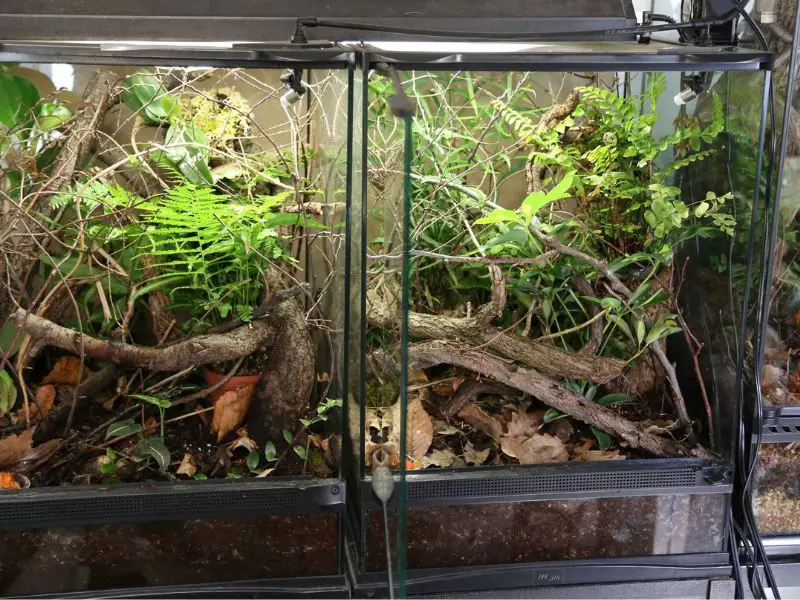
Pygmy chameleons are native to warm regions with a lot of vegetation and high levels of humidity. These conditions should be replicated in the chameleon’s enclosure to make sure they stay healthy and feel comfortable in their tank.
Pygmy chameleons only require a small enclosure due to their size, which can be placed well even in a limited living space.
Enclosure size
The pygmy chameleon needs a relatively small enclosure to feel at home. A single chameleon will thrive in a terrarium as small as five gallons.
When housing more than one pygmy chameleon, consider adding another five gallons to the enclosure space to ensure each reptile feels comfortable.
Because these lizards live near the ground in their natural habitat, they are not active climbers and would prefer to have more horizontal space.
The best dimensions for a pygmy chameleon tank are 16 inches in length, 8 inches in width, and 10 inches in height.
Lighting
Pygmy chameleons don’t need sophisticated lighting systems in their tank, nor do they require additional UVB light, as most reptiles do.
Because pygmy chameleons live on the forest floor or bushes near the ground, they need limited lighting, such as a simple fluorescent lamp and 12 hours of natural light per day to mimic the natural light cycle.
Temperature and Humidity
The pygmy chameleon requires consistent levels of temperature in the enclosure, matching the conditions of the reptile’s natural habitat.
Because these lizards live near the ground, in the grass or low-hanging bushes, and stay in the shade, they do not experience significant temperature changes throughout the day, which is why they don’t need basking areas and cooler areas.
The pygmy chameleon thrives in temperatures ranging between 65°F and 80°F. The best temperature for a pygmy chameleon The owner of a pygmy chameleon has to ensure that the temperature in the enclosure never rises above 80°F because a temperature this high can be fatal for the reptile.
Temperature below 65°F won’t kill the chameleon but may cause serious health issues if prolonged.
Pygmy chameleons are native to humid regions of East Africa, which is why they need a consistently high level of humidity in their tanks to stay healthy.
The best level of humidity for pygmy chameleons is 60%-80%, which can be achieved by spraying the enclosure with water twice a day – in the morning and in the evening.
The levels of humidity and temperature should be monitored by the owner with a hygrometer and thermometer installed in the enclosure.
There are digital devices that display both temperature and humidity levels which can make monitoring more convenient for the owner.
Substrate and Decoration
Pygmy chameleons are delicate creatures that require soft substrate in their habitat to prevent injuries and ensure comfort.
Coconut fiber is a good substrate option for a pygmy chameleon because it holds moisture well, supporting the level of humidity in the tank.
But substrate types like sand or gravel might not work as well, because chameleons can swallow particles that might cause indigestion.
Layer the coconut fiber substrate 2–4 inches deep. Coconut fiber can be layered on top of gravel if the owner wants to have live plants in the enclosure.
Because in the wild pygmy chameleons inhabit forested areas, these creatures will benefit from the rich vegetation in the tank.
Pygmy chameleons often hide in plants or climb them, so introducing live or artificial plants in the tank will help the pet feel more at home, as well as have a sense of security.
All plants, live or artificial, need to be thoroughly washed before being introduced into the tank to protect the chameleon from infections.
Pygmy chameleons may also nibble on the plants, so it’s best to make sure that the live plants introduced into the tank are safe for the lizard, and that the artificial ones are disinfected completely.
Some of the best live plants for a pygmy chameleon are rubber trees, yuccas, hibiscus, golden pothos, and the Madagascar dragon tree.
Pygmy chameleons will also enjoy a variety of rocks, sticks, and other decorative elements in the enclosure. All of the decorations need to be disinfected before being placed in the enclosure.
Cleaning
To keep the chameleon’s enclosure clean, make sure to avoid spraying the glass walls of the terrarium during daily misting’s to avoid leaving water trails on the glass.
Spot cleaning should be done daily to remove any leftovers, excrement, and other waste around the cage, and remove stains from the glass walls of the tank.
Deep cleaning should be performed once every few months. Change the substrate completely and remove all the decorations for disinfecting.
Disinfect the decorations by boiling them in water for 30 minutes, or clean them in the dishwasher.
Clean the walls and floor of the tank with a mild cleaning solution that can be made at home by mixing warm water with vinegar (1:1 ratio) or water with dish soap (1:1 ratio).
When using soap, make sure to thoroughly wash it off to leave no trace of chemicals in the tank.
When doing a deep cleaning, remove the pygmy chameleon with care and place the pet into a box or a container with walls that are high enough so it does not escape and get lost in the house.
Pygmy Сhameleon Care
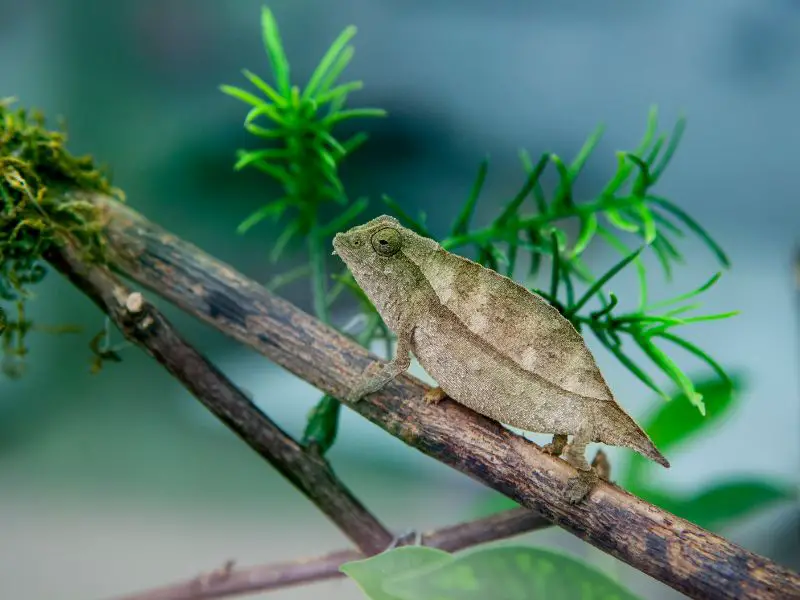
Despite minimal requirements to its habitat, the pygmy chameleon is a pet suitable for intermediate or even advanced owners.
These lizards may be fragile due to their small size and limited lifespan, so it’s important to ensure a diverse nutritious diet and extra attention to the reptile’s health.
Food and Water
Pygmy chameleons are insectivorous, which means the majority of their diet consists of small insects. Because these chameleons are so small, the food given to them should be the appropriate size so that the reptile can feed properly.
The insects fed to a pygmy chameleon should not be larger than the lizard’s head.
Some of the insects commonly given to small chameleons like the pygmy species include small crickets, house flies, fruit flies, or baby silkworms.
To ensure proper vitamin intake, dust the insects with a multivitamin supplement powder or calcium powder.
In addition, when feeding the pygmy chameleon live insects, feed the insects fresh fruits and vegetables a few hours before giving them to the pet.
Juvenile pygmy chameleons need to be fed daily. Young pygmy chameleons should be given smaller insects, like plenty of fruit flies, pinhead crickets, and roach nymphs.
Older chameleons can be fed every other day with small crickets, house flies, mealworms, and other insects appropriate for chameleons.
Make sure to give the reptile a range of different insects to ensure that the pet has a balanced nutritious diet.
It’s best to remove the remaining insects from the enclosure in the evening because, if left too long unattended, they can get too big and even bite sleeping chameleons.
Pygmy chameleons don’t require an additional water bowl in the enclosure because they drink water that remains on the walls of the enclosure and plants after misting.
For this reason, make sure to use clean water without chlorine when spraying the tank.
Handling
Pygmy chameleons are known to be friendly and docile pets which makes handling them quite easy for the owner. However, too much handling can be very stressful for these small reptiles, so it’s best to limit touching them.
Pygmy chameleons should not be handled for the first couple of weeks they spend in the enclosure, getting used to it.
After the two weeks have passed, pygmy chameleons can be handled every once in a while to help them get used to the human touch.
Pygmy chameleons should also be inspected every two to three weeks for signs of disease.
When touching the chameleon, make sure to be as gentle as possible and hold the reptile above a soft surface in case it gets stressed and tries to escape.
Common Health Issues
Pygmy chameleons are fragile creatures which are why it’s the owner’s responsibility to closely watch any signs of disease and be prepared to take the pet to an experienced veterinarian specializing in exotic pets.
These chameleons can develop a number of conditions that need to be treated with the help of a professional.
Pygmy chameleons sometimes suffer from mouth sores caused by bacterial infections that require medical treatment prescribed by a veterinarian.
If you see scratches on the chameleon’s body, make sure to take the pet to a specialist. The scratches can be the result of the chameleon being bitten by prey at night, and they can get infected quickly.
Like many reptiles, pygmy chameleons are vulnerable to metabolic bone disease. This condition is frequently caused by a lack of a balanced diet and can be prevented by giving the reptiles enough calcium and vitamin supplements.
Some other possible signs of the disease include lethargy, irregular skin pigmentation, irregular breathing, and lack of appetite. If these symptoms prevail, take the chameleon to a veterinarian to find treatment.
Breeding
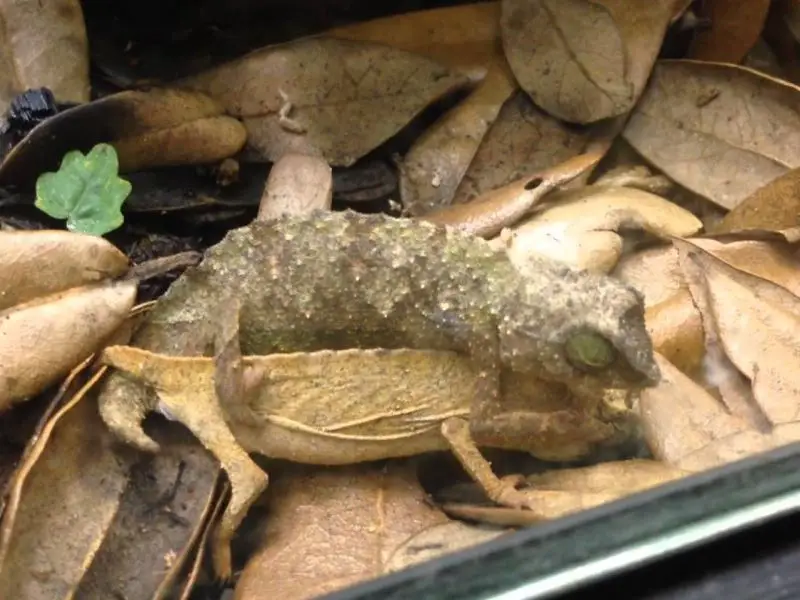
Pygmy chameleons are quite easy to breed in captivity if the conditions in the enclosure properly match those of their natural habitat.
However, it’s unlikely that any of the mating behaviors will be observed by the owner since these reptiles tend to hide a lot in the enclosure.
The male pygmy chameleon is unlikely to show any courting behaviors, and the female pygmy chameleon doesn’t change colors during the period of breeding.
Breeding will happen naturally when a male and a female pygmy chameleon are housed together in a large enough enclosure of 10 gallons.
The chameleons need to be housed in their usual temperature and humidity conditions in order to breed, as well as given a diverse nutritious diet to ensure they are healthy.
The chameleons need a thick layer of soft substrate in the enclosure, such as coconut fiber, so that the female pygmy chameleon can bury the eggs.
The owner will notice that the female is growing larger before laying her eggs. Because the pygmy chameleon eggs are tiny, the owner needs to look carefully around the enclosure to find them.
The eggs should be removed with care to avoid damage and placed in an incubator at a temperature of 70–75°F. The eggs will be incubated for a period of 45–90 days before hatching.
When the tiny pygmy chameleons are hatched, move them to a small enclosure with the appropriate conditions and start to feed them with tiny insects.
The hatchlings will grow large enough by the age of six months, after which they can be moved to a bigger enclosure.
Choosing and Buying a Pygmy Сhameleon
Pygmy chameleons are quite difficult to find in pet stores around the US. Most pet stores don’t sell these reptiles, so the best way to find a pygmy chameleon is through a reliable breeder.
Finding a good breeder also helps to avoid getting a pygmy chameleon with health problems and infections.
Don’t buy a pygmy chameleon online because the photo of the lizard doesn’t always give information about the state of its health.
It’s best to see the chameleon with one’s own eyes to make sure it is healthy. When choosing a pygmy chameleon, look for irregular coloration or any deformities on its body, which can be signs of poor health.
Most common pygmy chameleon varieties, like bearded pygmy chameleons, may cost between $25 and $50. Some of the rare varieties can cost up to $200.

